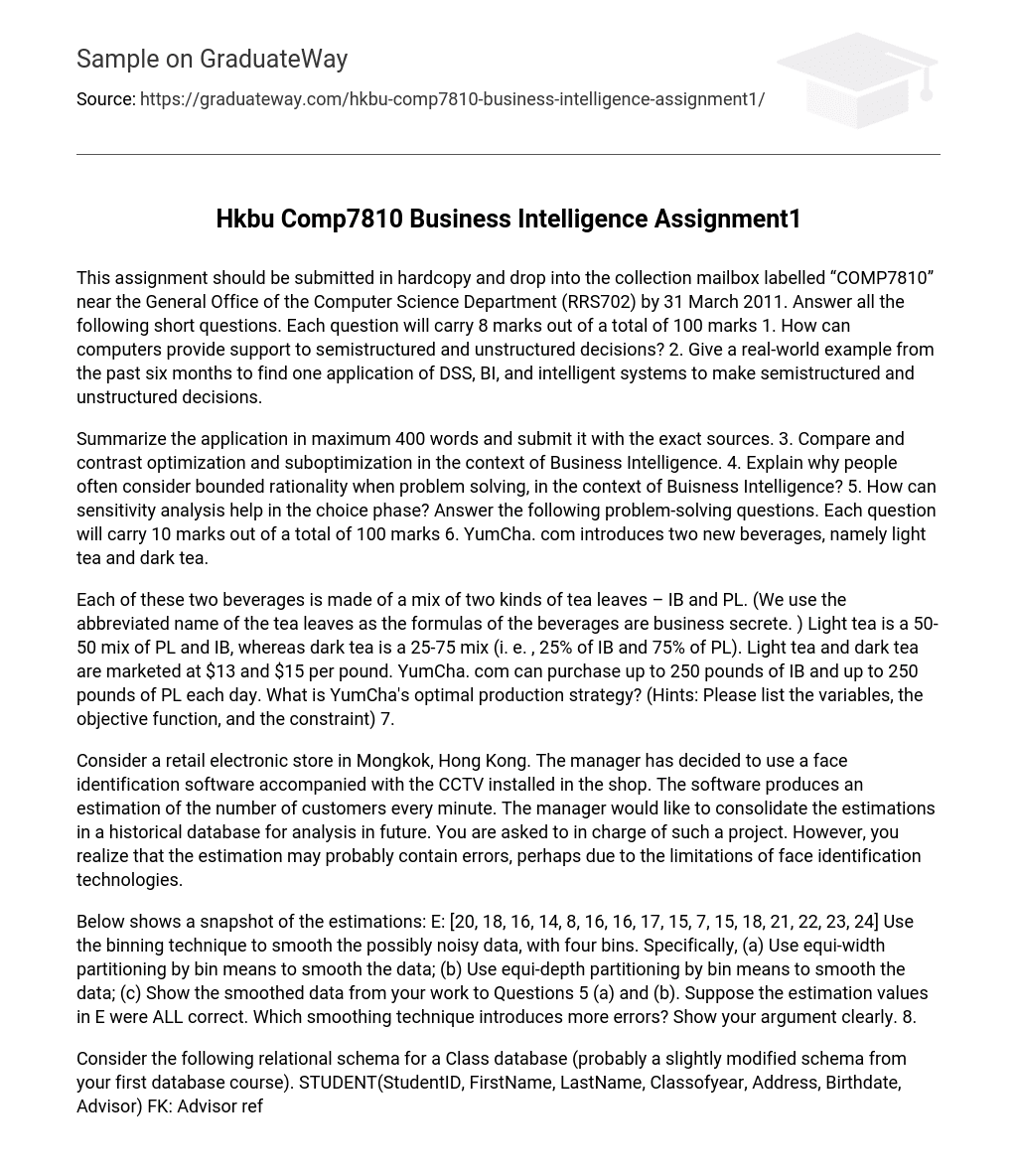This assignment should be submitted in hardcopy and drop into the collection mailbox labelled “COMP7810” near the General Office of the Computer Science Department (RRS702) by 31 March 2011. Answer all the following short questions. Each question will carry 8 marks out of a total of 100 marks 1. How can computers provide support to semistructured and unstructured decisions? 2. Give a real-world example from the past six months to find one application of DSS, BI, and intelligent systems to make semistructured and unstructured decisions.
Summarize the application in maximum 400 words and submit it with the exact sources. 3. Compare and contrast optimization and suboptimization in the context of Business Intelligence. 4. Explain why people often consider bounded rationality when problem solving, in the context of Buisness Intelligence? 5. How can sensitivity analysis help in the choice phase? Answer the following problem-solving questions. Each question will carry 10 marks out of a total of 100 marks 6. YumCha. com introduces two new beverages, namely light tea and dark tea.
Each of these two beverages is made of a mix of two kinds of tea leaves – IB and PL. (We use the abbreviated name of the tea leaves as the formulas of the beverages are business secrete. ) Light tea is a 50-50 mix of PL and IB, whereas dark tea is a 25-75 mix (i. e. , 25% of IB and 75% of PL). Light tea and dark tea are marketed at $13 and $15 per pound. YumCha. com can purchase up to 250 pounds of IB and up to 250 pounds of PL each day. What is YumCha’s optimal production strategy? (Hints: Please list the variables, the objective function, and the constraint) 7.
Consider a retail electronic store in Mongkok, Hong Kong. The manager has decided to use a face identification software accompanied with the CCTV installed in the shop. The software produces an estimation of the number of customers every minute. The manager would like to consolidate the estimations in a historical database for analysis in future. You are asked to in charge of such a project. However, you realize that the estimation may probably contain errors, perhaps due to the limitations of face identification technologies.
Below shows a snapshot of the estimations: E: [20, 18, 16, 14, 8, 16, 16, 17, 15, 7, 15, 18, 21, 22, 23, 24] Use the binning technique to smooth the possibly noisy data, with four bins. Specifically, (a) Use equi-width partitioning by bin means to smooth the data; (b) Use equi-depth partitioning by bin means to smooth the data; (c) Show the smoothed data from your work to Questions 5 (a) and (b). Suppose the estimation values in E were ALL correct. Which smoothing technique introduces more errors? Show your argument clearly. 8.
Consider the following relational schema for a Class database (probably a slightly modified schema from your first database course). STUDENT(StudentID, FirstName, LastName, Classofyear, Address, Birthdate, Advisor) FK: Advisor references STAFF STAFF(StaffID, FirstName, LastName, FirstAppoint) FK: DeptID references DEPARTMENT Title, AcadQual, Roomno, Tel, DeptID, COURSE(Courseno, Title, Description, Unit) DEPARTMENT(DeptID, Name) ENROLLS(Courseno, StudentID, Semester, Year, Labmark, Exammark, Grade) FK: Courseno references COURSE and StudentID references STUDENT
TEACHES(Courseno, StaffID, Semester, Year) FK: Courseno references COURSE and StaffID references STAFF You are asked to design a data warehouse to analyze the historical students’ performance on courses. Show the schema for your data warehouse. (Hints: (i) Perform proper data selection; and (ii) Show the fact and dimension tables clearly and primary and foreign keys. ) 9. Consider the following items in a supermarket: milk, bread, and fruit juice. Supposing the following information is recorded in the supermarket database: 30% of all customer ransactions purchased milk, 25% of all transactions purchased bread, and 35% of all transactions purchased fruit juice. In addition, 15% of all transactions purchased all three items together. Determine which of the following rules has a confidence of at least 45% and a support of at least 10%. fruit juice milk & bread bread milk & fruit juice milk fruit juice & bread. You should also clearly indicate the support and confidence of each rule. 10. Consider the following data in the database. Transaction# T100 T200 T300 T400 T500 T600 T700 T800 T900 Items List A, B, E B, D B, C A, B, D A, C B, C A, C A, B, C, E A, B, C
Assuming we use an absolute support of 2 (i. e. a relative support of 2/9 = 22%), determine the frequent itemsets L1, L2, L3 and L4. 11. Consider the following set of product records, giving the reliability rating and the weight of each product Product 1 2 3 4 5 6 Reliability Rating 8 5 2 2 2 8 Weight (kg)___ 4 4 4 6 8 6 Use the k-means algorithm to cluster the data. You may assume k = 3, and that Products 1, 3, and 5 are used for the initial cluster centroids. Is there more than one way of forming the clusters?





